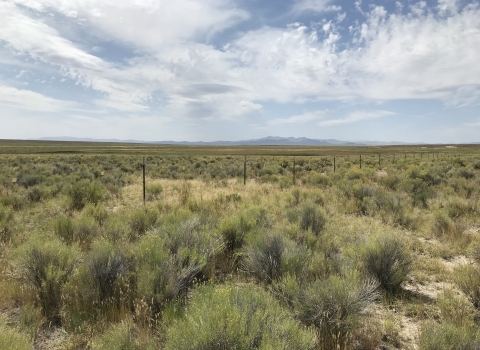San Diego, Calif. – Yesterday, U.S. Marine Corps Base Camp Pendleton received the U.S. Fish and Wildlife Service’s 18th Annual Military Conservation Partner Award for its significant contributions to natural resource management and listed species.
Paul Souza, Regional Director of the Service’s Pacific Southwest Region, presented Brigadier General Jason Woodworth, Commanding General, Marine Corps Installations West-Marine Corps Base, Camp Pendleton, with the award, following a site visit to multiple restoration projects on the base.
“Camp Pendleton is a conservation leader and shining example of what can be accomplished for species recovery on military land,” said Souza. “We are grateful for their dedication and stewardship and look forward to a continued partnership.”
“Here at Marine Corps Installations-West, our mission is to support, sustain and train the deploying warfighter,” said Woodworth. “We do that every day while remaining good stewards of our environment and our natural resources, thanks to the support and coordination from the U.S. Fish and Wildlife Service and our Environmental Security experts. We are honored to receive this award and are excited to continue our partnership with the U.S. Fish and Wildlife Service for years to come.”
The base’s Environmental Security Department collaborated with the Service, the state of California, and multiple public and private organizations to restore and protect habitat for 19 federally endangered and threatened species.
Camp Pendleton’s aggressive conservation of riparian riparian
Definition of riparian habitat or riparian areas.
Learn more about riparian , beach and estuarine ecosystems supports recovery of the tidewater goby, coastal California gnatcatcher, and numerous other fish and bird species, as well as the last remaining coastal populations of the arroyo toad. Their fish passage fish passage
Fish passage is the ability of fish or other aquatic species to move freely throughout their life to find food, reproduce, and complete their natural migration cycles. Millions of barriers to fish passage across the country are fragmenting habitat and leading to species declines. The U.S. Fish and Wildlife Service's National Fish Passage Program is working to reconnect watersheds to benefit both wildlife and people.
Learn more about fish passage projects on the Santa Margarita River and other waterways are contributing to recovery of southern California steelhead and other imperiled fish.
Conservation and management of the least Bell’s vireo, California least tern, and western snowy plover have resulted in significant increases to on-base populations of these species. Predator control efforts helped enable the Pacific lamprey to return to Camp Pendleton after decades of absence.
Additionally, the base supports robust outdoor recreation programs including hunting, fishing, hiking, camping, swimming and surfing.
The Service’s Fish and Aquatic Conservation program established the award in 2004 to recognize military installations for their outstanding work to conserve important wildlife and their habitats on military land. The program serves to strategically improve aquatic habitat, restore connectivity of the nation’s waterways, prevent infestations of invasive species invasive species
An invasive species is any plant or animal that has spread or been introduced into a new area where they are, or could, cause harm to the environment, economy, or human, animal, or plant health. Their unwelcome presence can destroy ecosystems and cost millions of dollars.
Learn more about invasive species , and enhance recreational use of aquatic resources.
Photos of Camp Pendleton restoration projects and associated species are available at: https://www.flickr.com/photos/usfws_pacificsw/albums/72177720301965253
The U.S. Fish and Wildlife Service works with others to conserve, protect, and enhance fish, wildlife, plants, and their habitats for the continuing benefit of the American people. For more information about our work and the people who make it happen, visit https://www.fws.gov or connect with us via Facebook, Twitter, YouTube, Instagram, Flickr and Linkedin.


